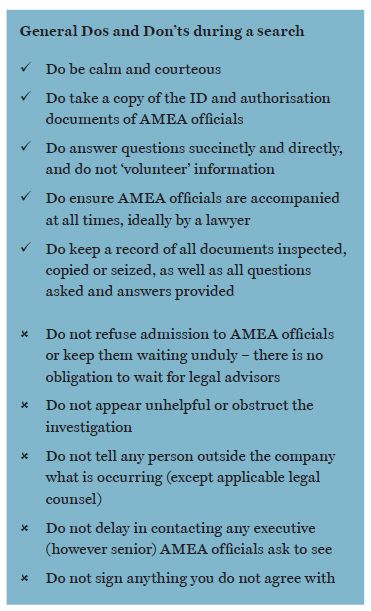Keywords: AML investigations, AMEAs, SAID, NDRC, conduct rules
Part III - Are You Ready for a Dawn Raid?
Parts 1 and 2 of this special three-part legal update highlighted current developments and investigations undertaken by the Anti-Monopoly Enforcement Authorities (AMEAs) responsible for enforcing the behavioural prohibitions under the Anti-Monopoly Law (AML) - the State Administration of Industry and Commerce (SAIC) and the National Development and Reform Commission (NDRC).
In light of the increasing enforcement activities of the AMEAs in relation to the AML's 'conduct rules' (such as those dealing with cartels, vertical agreements and abuse of a dominant market position), now more than ever businesses must be ready and prepared to deal with an AML investigation in a way that best protects the interests of the business. Appropriate planning and training is crucial and should be a priority for businesses with substantial operations in China, especially since AMEA officials are authorised to conduct on-site investigations without providing any prior notice to the business subject to the investigation.
In the final part of this update, we provide some high-level recommendations and practical guidance on how businesses in China should respond to the launch of an AML-related investigation into their operations - and in particular an on-site investigation.
Key objectives
A business that is subject to an investigation under the AML will want to stay in control of the situation, be proactive, and minimise any potential damage, in terms of both possible penalties and reputational impact. How an investigation is handled can make all the difference to a business's prospects of being found to have infringed the AML, and whether leniency is granted by the AMEAs in relevant cases.
In this context, relevant front-line staff (such as receptionists, legal advisors and designated response teams) should undergo advance training so that they are aware of:
- how to respond to access and information requests made by AMEA officials;
- whether to submit to questioning, and if so, what they should and should not say;
- what their right and obligations are in terms of aiding the investigation and allowing review of documents;
- who to contact for support; and
- the risk of substantial fines, and even criminal penalties in some cases, for hindering an AMEA investigation (such as by failing to provide information, destroying evidence, or otherwise impeding the investigation).
Preparation is key
The AML provides the AMEAs with broad powers to enter onto the premises of a business operator (or even the residential premises of business employees) to search for relevant documents, copy or confiscate relevant materials, and conduct questioning of business representatives without providing any prior notice to the investigated business. It is therefore important that businesses already have in place procedures for staff to follow in the event of a dawn raid.
At the basic level, businesses should ensure that reception staff and other key personnel in each major business premises have the contact details of relevant internal or external lawyers to contact, and a copy of a guidance document, so that they can respond quickly in the event of an AMEA on-site investigation. We have created a broad checklist of recommended procedures below.
Each business centre should have an appointed response team that is ready to deal with any on-site investigation. Where possible, the team should include a lawyer, staff who can assist with note-taking and photocopying, and staff that can handle any necessary media or public relations liaison. For example, during the on-site inspection, one staff member should focus on creating a written record of the investigation process, including areas visited, staff spoken to, documents inspected or copied, and comments made by the officials. Another staff member should assist with any requests made by AMEA officials (such as organising copies of relevant documentation), and a further staff member (ideally, a lawyer) should be in charge of all further liaison with the officials.

In preparation for any AML investigation or on-site inspections by an AMEA, a business should have already identified legal experts who have experience assisting businesses to deal with AML issues and who can immediately be engaged to attend relevant premises in China where on-site investigations are being conducted.
What next after an on-site inspection?
As a first priority, a business should cease any conduct likely to be the cause of AMEA suspicions or concerns immediately. This is especially the case where the conduct that was the cause of the AMEA investigation is plainly evident and unlawful, and steps should be taken to cease that conduct (and to remedy any clear damage those steps may have caused to other parties) as soon as possible, in consultation with legal advisors. A written record should be taken of such steps, for potential use in any subsequent attempts to secure leniency.
A comprehensive risk-assessment review by external counsel should promptly follow any on-site AMEA investigation of a business.
Dawn Raid Checklist
Upon arrival of AMEA officials
1. Contact legal advisors and other key business centres for assistance
- Ask in-house (or external) counsel to attend the location immediately
- Inform the business's other key centres about the prospect of possible on-site investigations at their locations
- Ask if the attending officials can wait in a closed meeting room until the business's legal advisors arrive (however they should not be refused entry to other areas of the premises if they insist on this)
2. Review and confirm official documentation is in order
- Are the requisite two AMEA officials are present? If no, request that the investigation be put on hold until the second official arrives
- Verify officials' ID cards and authorisation documents and make photocopies
- Note the authorised scope of investigation and communicate to all business representatives involved in dealing with the officials, so they understand the subject matter of the investigation and the extent of their obligation to assist.
During the on-site inspection
1. Alert all staff within the premises that the investigation is taking place
- Advise staff to cooperate with relevant requests by AMEA officials or instructions from the accompanying business response team
- Response team staff should accompany the officials throughout their inspection
2. Provide assistance to AMEA officialsProvide reasonable assistance to officials upon request
- Check if any document requested to be copied or removed falls within the scope of the authorised investigation
- An objection should be recorded in cases where it is apparent that officials are exceeding the scope of their authority
- Where copies of documents are requested to be made, two such copies should be made - one for the officials and one for the business's future reference
3. Dealing with questions
AMEA officials are authorised to question business representatives on matters relating to the investigation. Where the officials seek to exercise this right, the following procedures should be adhered to:
- Staff should request the questions in writing, and the opportunity to provide subsequent written responses (however, officials may refuse such a request and proceed with oral questions at the time of the on-site investigation)
- Lower-level staff should advise the officials that answers to their questions may be more appropriately provided by senior-level staff, and should request permission to involve such staff in the interviews (again, officials may refuse)
- Staff should seek to ensure a legal advisor is present to assist them to cooperate and respond to questions appropriately, and another staff member should keep a written record of all questions asked and answers given
- Responses should be kept short, and should be factual and accurate
- Information should not be volunteered, and staff should not provide answers that are speculative or based on guesswork
4. Reinforcing the confidentiality of information obtained
- In relation to any documents seized or copied by AMEA officials, staff should state that the business claims confidentiality over such documents and the information they contain
5. Verifying the investigation record
- Staff who were questioned and asked to review and sign such records should try and obtain a copy, and request the opportunity to review them in detail (ideally, with a legal advisor) before providing any signature to verify their contents
Upon conclusion of the on-site inspection
1. Request from the AMEAs a list of documents copied/seized
2. Be aware of any steps taken by AMEA officials to seal documents or places of evidence
- Advise all staff on the business premises that they may not break the seals under any circumstances
Learn more about our PRC offices and Antitrust & Competition practice.
Originally published September 3, 2013
Visit us at www.mayerbrown.com
Mayer Brown is a global legal services organization comprising legal practices that are separate entities (the Mayer Brown Practices). The Mayer Brown Practices are: Mayer Brown LLP, a limited liability partnership established in the United States; Mayer Brown International LLP, a limited liability partnership incorporated in England and Wales; Mayer Brown JSM, a Hong Kong partnership, and its associated entities in Asia; and Tauil & Chequer Advogados, a Brazilian law partnership with which Mayer Brown is associated. "Mayer Brown" and the Mayer Brown logo are the trademarks of the Mayer Brown Practices in their respective jurisdictions.
© Copyright 2013. The Mayer Brown Practices. All rights reserved.
This article provides information and comments on legal issues and developments of interest. The foregoing is not a comprehensive treatment of the subject matter covered and is not intended to provide legal advice. Readers should seek specific legal advice before taking any action with respect to the matters discussed herein. Please also read the JSM legal publications Disclaimer.


